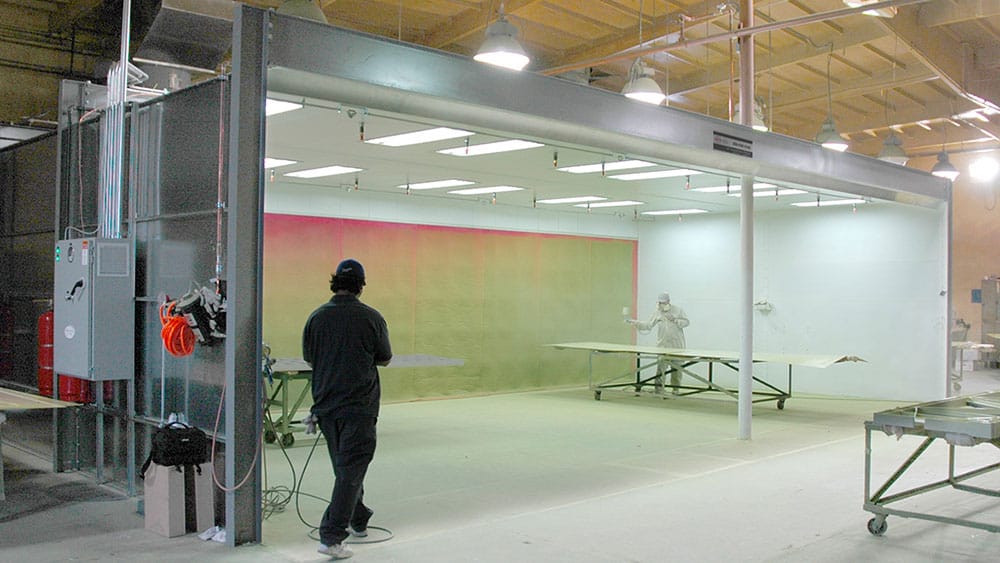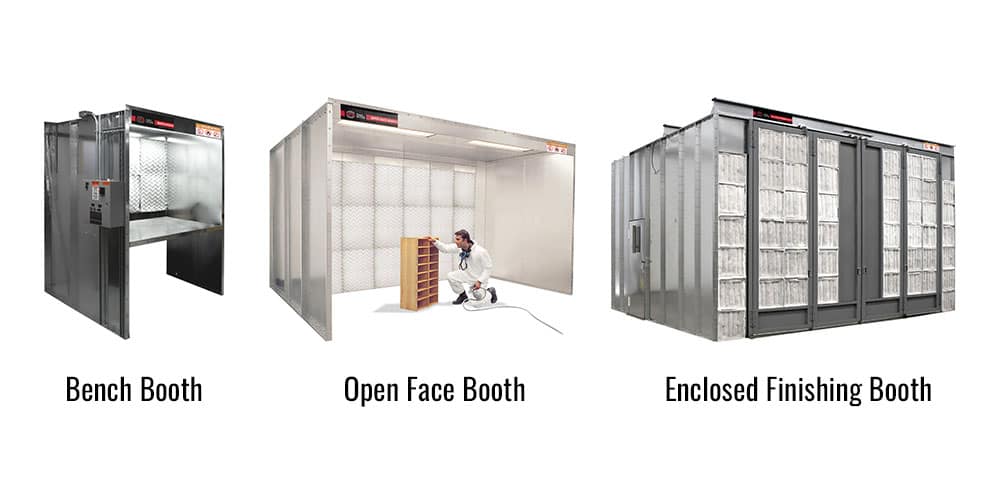
It is not uncommon for customers to want to enclose their open face paint booth with curtains or doors. Enclosing a painting environment prevents contaminants from entering paint jobs, leading to higher-quality finishes.
While curtains are more affordable than doors and may offer more flexibility for product entry, they do not provide the level of protection from contaminants that is needed for the best possible finish. Let’s examine the differences between curtains and filtered doors on an open front paint booth:
Many businesses and manufacturing facilities place a curtain on an open face booth as a way to boost production and increase versatility, taking their business to the next level.
When putting a curtain on an open front booth, most of the opening through which fresh air enters the booth is closed off. Because a source of fresh air is still needed, a booth can be pressurized with an intake fan or air make-up unit (AMU).
If an open face booth is not pressurized, the curtain will be sucked into the booth when the exhaust system is turned on, defeating the purpose of the curtain. However, since there are gaps around the curtain from which air could enter, the booth must be maintained at a slightly negative pressure to ensure that overspray and vapors are confined to the booth.
“You have to let air into the booth because you are taking air out. Since a curtain is not rigid, it is also hard to hold it in place with the negative pressure in the booth,” said Geoff Raifsnider, a senior mechanical engineer for Global Finishing Solutions (GFS).
Outfitting an open face booth with a curtain meets NFPA requirements, however, the curtain itself must be code compliant. According to NFPA 701, a curtain must be made of a material that will melt and fall onto the floor in the case of a fire — as opposed to bursting into flames, which would accelerate the blaze.
“If you install a curtain on a spray booth, it has to meet certain NFPA standards. You can’t just slap a shower curtain from Walmart on a booth,” said Raifsnider.
For certain applications, a curtain with a fan or AMU on an open front booth might provide the desired result. But for applications in which the finish quality is a high priority, a filtered product door provides better protection from contamination of the painted surface.
Enclosing an open face booth with a filtered door eliminates the need for an air intake system. The air required to enter the booth passes through the filters in the door, capturing some or all of the contaminants.
Placing a solid door on an open front booth is an option as well. However, this requires a fan or AMU to pressurize the booth, like what is needed when adding a curtain. A solid door does not offer the flexibility of a curtain — products and parts cannot be freely moved in and out of the booth.
When choosing between a curtain and filtered door to enclose an open face booth, a filtered door is your best option for maintaining finish quality. A filtered door provides a better seal against contaminants and does not require an additional air intake system. The gains in efficiency with a filtered door should heavily outweigh the investment cost, allowing you to produce high-quality finishes with fewer contaminants in your paint jobs and reduced rework.

One of the best ways to highlight your business is through a story that you can share across your online platforms. It humanizes your business and shows that your business can make a meaningful impact. Your testimonial would be used as a project profile on the GFS Booth Blog and can be shared on your website and/or social media channels.
Complete this form and we’ll be in touch to showcase your company.

Shop a variety of GFS aftermarket products, including booth protection products and mobile accelerated curing units. And enjoy the convenience of fast and free ground shipping throughout the contiguous United States.

Located at GFS’ headquarters in Osseo, Wisconsin, the Center for Excellence is an innovative facility featuring an automotive refinish training center, as well as a separate space dedicated to technical product training.

GFS is continuously searching for talented, ambitious individuals to join our team. We aim to provide our employees with every opportunity to make an impact on the company and find their niche along the way — weather in a production, field services or an office position.